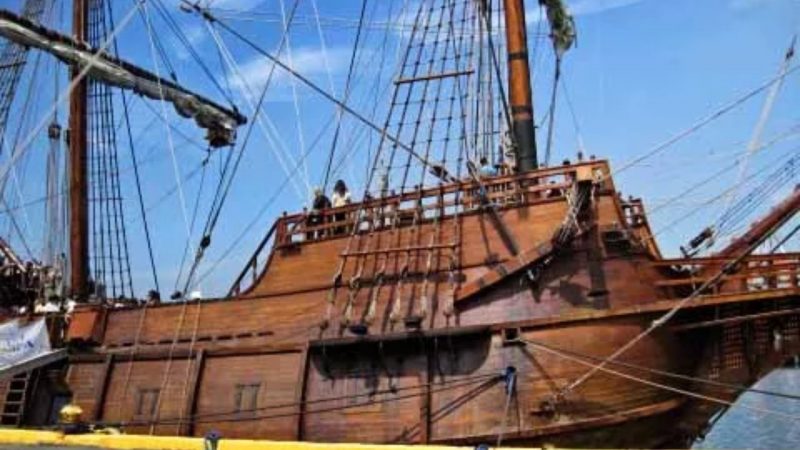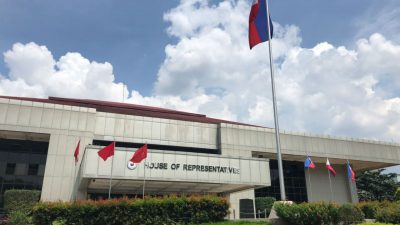September 14, 2023
Photo shows the Galeon Andalucia, a replica of the 17th Century vessels that sailed between Manila and Acapulco during the galleon trade
PHILIPPINES
On September 14, 1815, the galleon trade between the Philippines and Mexico ended a few years before Mexico gained independence from Spain in 1821.
The Galeon Andalucia, a replica of the 17th Century vessels that sailed between Manila and Acapulco during the galleon trade.
The Spanish Crown took direct control of the country, and was governed directly from Madrid. The opening of the Suez Canal and the invention of steam ships, which reduced the travel time from Spain to the Philippines to 40 days, made this more manageable.
Galleon trade became the fundamental income-generating business for Spanish colonists living in the Philippine Islands with a total of 110 Manila galleons set sail in the 250 years of the Manila-Acapulco galleon trade (1565 to 1815).
The Manila galleons or Manila-Acapulco galleons sailed the Pacific for nearly three centuries, bringing to Spain their cargoes of luxury goods, economic benefits and cultural exchange.
However, galleon trade benefited only a very small coterie of privilege Spaniards – the Spanish governor, members of the consulado (merchants with consular duties and rights) usually insulares, and Spanish residents in Manila.
Positive results of the galleon trade were the intercultural exchanges between the Philippines and the Americans, symbolized by no less than the Mexican-made Virgin of Antipolo, chosen as the patroness of the sailors, who protected them from the untold perils across the Pacific.
The mango de Manila, tamarind and rice, the carabao (known by 1737 in Mexico), cockfighting, Chinese tea and textiles, fireworks display, tuba (coconut wine) making came to Mexico through the trans-Pacific trade.
In exchange, the return voyage brought innumerable and valuable flora and fauna into the Philippines: avocado, guava, papaya, pineapple, horses and cattle.
The moro-moro, moriones festival, and the image of the Black Nazarene of Quiapo, were also of Mexican origins.
The Manila-Acapulco galleon trade began when Andres de Urdaneta in convoy under Miguel Lopez de Legaspi, discovered a return route to Mexico in 1565. (Source: Philippine News Agency Archives)
WORLD
2000 Microsoft Launches Windows ME
The Millennium Edition was the last of the operating systems of the Windows 9x series.
1985 The Golden Girls Make Their Television Debut
The popular American sitcom about 4 single and older women living together in a Miami, Florida house ran for 6 seasons on NBC. The main characters in the show were played by Beatrice Arthur, Estelle Getty, Rue McClanahan, and Betty White, each of whom won the Emmys for their acting in the show. The series also won 2 Primetime Emmy Awards for Outstanding Comedy Series and 3 Golden Globe Awards for Best Television Series.
1979 The Afghan President is assassinated
Nur Muhammad Taraki had taken office less than a year ago when he was killed by gunfire at the behest of Hafizullah Amin. Amin took the seat of the president after the assassination and ruled for only 3 months before he was killed by the Soviets during Operation Storm-333.
1959 First Man-Made Object Successfully Lands on the Moon
Soviet space probe Luna 2 was also the first man-made spacecraft to land on any celestial object. It was launched on September 12, 1959, and lost communications with Earth as it impacted the Moon’s surface east of Mare Serenitatis near the Aristides, Archimedes, and Autolycus craters.
1956 IBM 305 RAMAC is Released
The 350 RAMAC was the first computer with a disk drive and was primarily targeted towards business that did real-time transactions. RAMAC stood for Random Access Method of Accounting and Control. The RAMAC 350, which was one of the last vacuum tube computers manufactured by IBM, was replaced by the IBM 1401 in the early 1960s.
(Compild by Jr. Amigo/ai/mnm)







